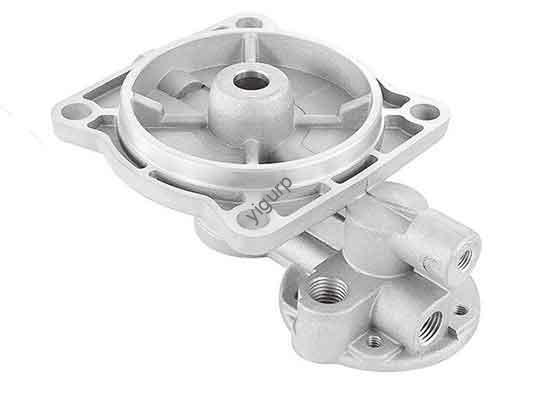If you’re developing prototypes or small-batch parts in Singapore, Vakuumguss (also called urethane casting) ist ein Game-Changer. It uses a vacuum to draw liquid resin into silicone molds, creating high-precision parts that mimic production-grade materials—faster and cheaper than injection molding. For local businesses, it cuts R&D time by up to 50% and slashes tooling costs to 20-30% of traditional methods . Egal, Elektronik, oder medizinische Geräte, it bridges the gap between prototypes and market-ready products.
How Vacuum Casting Works: Eine Schritt-für-Schritt-Aufschlüsselung
The process is straightforward but requires precision—here’s how Singaporean manufacturers execute it:
- Master -Mustererstellung
Erste, a master model of your part is made using 3D Druck oder CNC -Bearbeitung. Singaporean shops like RP World often use 3D printing for complex designs, ensuring the master matches your CAD file exactly . The master is inspected for flaws before moving forward.
- Silikonform
The master is submerged in liquid silicone, which cures around it (Typischerweise 24-48 Std.). Once set, the mold is cut into two halves, and the master is removed—leaving a cavity that mirrors your part. These molds last 10-20 Verwendung, Abhängig von der Komplexität .
- Vakuumguss & Heilung
Harz (Z.B., Polyurethan) is poured into the mold, which is then placed in a vacuum chamber to eliminate air bubbles (critical for clear or detailed parts). The mold goes into an oven for 3-4 hours of constant-temperature curing . Endlich, Die Form wird geöffnet, and the part gets post-processed (Malerei, Lasermarkierung, usw.).
Fallbeispiel: A global automation firm in Singapore struggled with CNC-machined impeller assemblies that failed underwater tests. RP World switched to vacuum casting: they 3D-printed a master, made a silicone mold, and cast parts that passed long-term underwater trials—cutting production time by half and becoming the client’s long-term supplier .
Key Advantages of Vacuum Casting for Singapore Businesses
Why choose this over 3D printing or injection molding? Here’s how it benefits local teams:
- Geschwindigkeit: Get 20 Teile in 15 days or less —ideal for tight R&D deadlines.
- Kosteneffizienz: Silicone molds cost far less than steel/aluminum injection molds. Für 100 Teile, vacuum casting saves 30-60% vs. Injektionsformung .
- Qualität: Parts have superior surface finish (smoother than injection molding) and capture fine details like textures or undercuts .
- Flexibilität: Verwenden 11+ resin types (Z.B., heat-resistant for automotive, transparent for lenses) and add post-processing like screen printing.
Top Materials for Vacuum Casting in Singapore
Singaporean suppliers offer a wide range of resins to match your part’s needs. Hier ist ein kurzer Leitfaden:
| Materialtyp | Schlüsseleigenschaften | Gemeinsame Verwendungen |
| Hei-Cast PU 8150 | ABS-like rigidity | Gehege, Fälle |
| Axson PX 5212 | Transparent, hohe Klarheit | Objektive, Anzeigeabdeckungen |
| Hey Cast 8752 | Flexibel (gummiartig) | Dichtungen, Wearables |
| High-Temp Resins | Wärmewiderstand (bis zu 200 ° C.) | Kfz -Motorteile |
Für die Spitze: Jucheng Precision, a Singapore-certified (ISO 9001, Iatf 16949) shop, recommends Hei-Cast 8400 for parts needing both strength and impact resistance .
2025 Trends Shaping Vacuum Casting in Singapore
The industry is evolving fast—here’s what local businesses need to know:
- Automatisierung & 24/7 Produktion
Shops like SM Metal Solutions are adding automated mold prep and part extraction, reducing human error and enabling round-the-clock production . This boosts output by 30% while cutting labor costs.
- AI-Powered Optimization
AI systems now analyze casting cycles to predict mold maintenance and reduce waste. Zum Beispiel, AI can spot resin flow issues early, sicherstellen 99% of parts meet quality standards —critical for medical device makers.
- Eco-Friendly Resins
With Singapore’s strict sustainability rules, suppliers are adopting recyclable resins that cut waste to 5-10% (vs. 20-30% for CNC machining) . Look for shops using bio-based polyurethanes.
How to Calculate Vacuum Casting Costs in Singapore
Costs depend on four factors—use this breakdown to budget:
- Material (40-60% of total cost): PU resins cost SGD 20-50 pro kg; high-temp resins go up to SGD 80/kg .
- Mold Fees: A small mold (10x10cm) costs SGD 300-500; large/complex molds reach SGD 1,500 .
- Volumen: Unit costs drop 40% when producing 100 vs. 10 Teile (spreads mold costs).
- Nachbearbeitung: Painting adds SGD 5-15 pro Teil; laser marking is SGD 2-8 pro Teil .
Beispiel: 50 ABS-like parts (10x5cm) mit Malerei: ~SGD 1,800 gesamt (Schimmel: SGD 400, Material: SGD 800, labor/post-processing: SGD 600).
Perspektive der Yigu -Technologie
“Vacuum casting is the unsung hero of Singapore’s manufacturing ecosystem. We’ve seen clients cut R&D timelines by 60% using this method—especially in electronics, where fast prototyping wins markets. The key is partnering with shops that combine ISO certifications with AI tools: they deliver consistent quality while keeping costs low. As sustainability rules tighten, we’re advising clients to prioritize eco-resins—they don’t just meet regulations but also appeal to green-conscious buyers. Für kleine Chargen (10-500 Teile), vacuum casting beats injection molding every time.”
FAQ: Vacuum Casting Singapore
Q: How long does vacuum casting take in Singapore?
A: 7-10 Tage für einfache Teile; Komplexe Designs (mit Nachbearbeitung) nehmen 12-15 Tage .
Q: Can vacuum casting make metal parts?
A: No—stick to plastics/rubbers. Für Metalle, Singaporean shops use die casting (Z.B., SM Metal Solutions) .
Q: Is vacuum casting better than 3D printing?
A: For functional prototypes or small batches, yes—parts have better material strength and surface finish . 3D printing is better for 1-5 Teile.
Q: Which industries use vacuum casting most in Singapore?
A: Automobil (Laufräder, Gehäuse), Unterhaltungselektronik (Telefonkoffer, Wearables), und medizinisch (device enclosures) .
